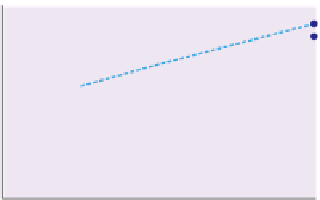Biology Reference
In-Depth Information
the opposite of the results in Figs 6.7b and 6.7c. This suggests that individuals in larger
groups do indeed detect predators sooner (Krause & Ruxton, 2002).
Are larger groups more vigilant? Brian Bertram (1980) studied small groups of ostriches
Struthio camelus
in Tsavo National Park, Kenya, where they feed out on the open plains and
are vulnerable to attack by lions. He found that as group size increased, individual ostriches
reduced the proportion of time they had their head up, scanning the environment (Fig.
6.8a). Nevertheless, the overall vigilance of the group (at least one individual scanning)
increased with group size. This increase was as predicted if each bird raised its head
independently of the others (Fig. 6.8b). The ostriches also raised their heads at random
time intervals, which makes it impossible for a stalking lion to predict how much time it has
to creep forward undetected in between look-ups by its victim. Any predictable pattern of
looking could be exploited by the lion in its tactics of approach.
These data suggest that prey could gain a double advantage in vigilance by grouping;
firstly, individuals in groups could scan less and so devote more time to feeding and,
secondly, many eyes improve overall vigilance in the group. However, the relationship
between individual vigilance and group size can be complex and involve many effects
(Roberts, 1996). For example, as group size increases an individual's risk of predation
declines due to dilution as well as through many eyes and both these effects may lead to
reduced individual vigilance. Furthermore, increased group size may increase feeding
competition, so individuals may have to devote more time to feeding, in which case
reduced scanning could sometimes be a cost of larger groups rather than a benefit.
Ostriches scan at
random
Response to others' alarms
Do individuals benefit by responding to the alarms of others in the group or do they
have to wait to respond to the predator itself ? Magurran and Higham (1988) used a
(a)
(b)
40
30
If independent
20
40
Observed
10
30
1
2
3 and 4
1
2
3 and 4
Number of birds in group
Number of birds in group
Fig. 6.8
Vigilance in groups. (a) An ostrich spends a smaller proportion of its time
scanning (head up) when it is in a larger group. (b) The overall vigilance of the group
(at least one bird scanning) increases with group size (solid line) and follows the relationship
expected if each individual looks up independently of others in the group (broken line).
From Bertram (1980). With permission from Elsevier.
















































